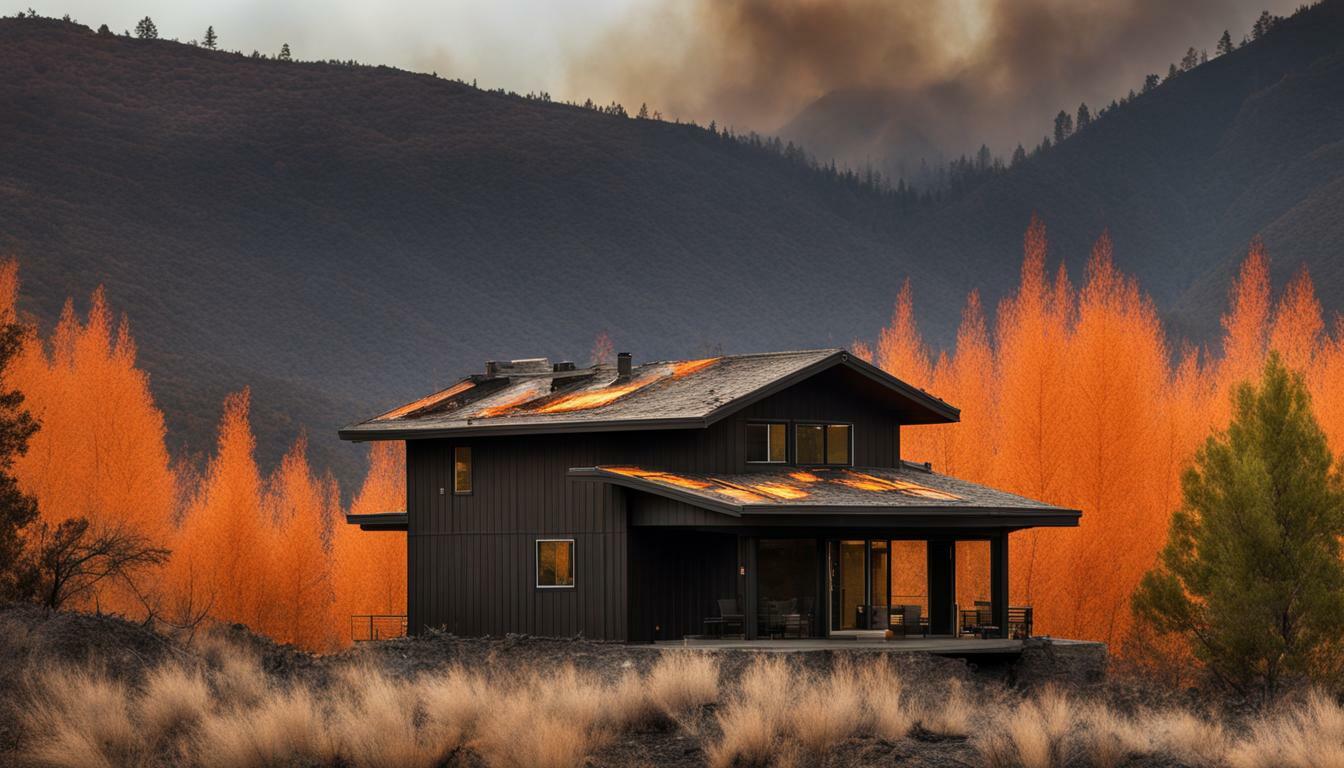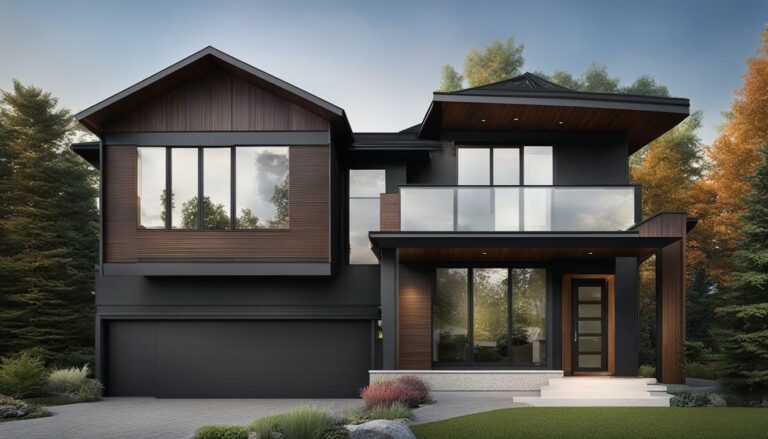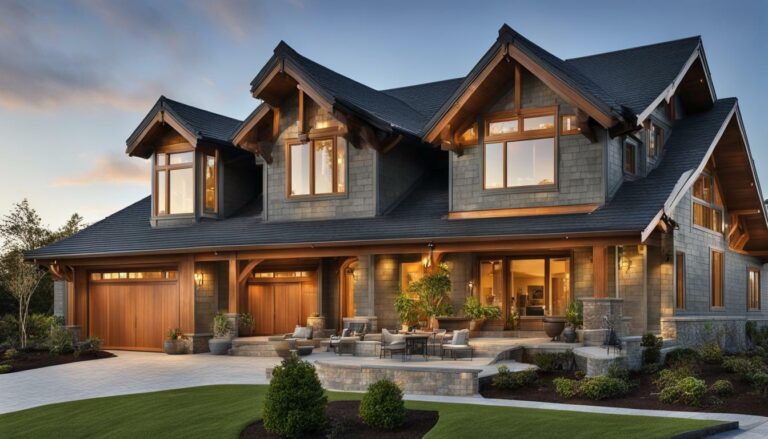Discover the Best Fire-Resistant Roofing Materials for Your Home
If you live in an area prone to wildfires, ensuring your home is equipped with the best fire-resistant roofing materials is of utmost importance. These materials can impede the spread of wildfires and protect your home from severe damage. The United States Forest Service has set guidelines for creating wildfire-resistant homes, emphasizing the use of fireproof roofing materials that are resistant to fire embers, fire radiation, and ignition.
Key Takeaways:
- Fire-resistant roofing materials are essential for homes in wildfire-prone areas.
- The United States Forest Service has guidelines for creating wildfire-resistant homes, including the use of fireproof roofing materials.
- Options for fire-resistant roofing materials include asphalt shingles, concrete and clay tiles, slate tiles, metal roofing, and synthetic roofing shingles.
- Synthetic roofing shingles, like those offered by CeDUR, combine aesthetics, safety, and durability.
- Choosing Class A-rated fire-resistant roofing materials can significantly reduce the risk of fire damage.
Understanding Fire-Resistant Roofing Materials and Their Benefits
Fire-resistant roofing materials have gained popularity in fire-prone areas due to their ability to provide an added layer of protection for homes. In areas where wildfires are a constant threat, having a fire-resistant roof can significantly reduce the risk of fire damage. These materials are designed to impede the spread of wildfires, protect homes from severe damage, and help homeowners comply with the guidelines set by the United States Forest Service’s Wildland-Urban Interface (WUI) Code.
The WUI Code specifies the use of fireproof roofing materials that are resistant to fire embers, fire radiation, and ignition. It aims to create wildfire-resistant homes that can withstand the harsh conditions often present in fire-prone areas. By choosing fire-resistant roofing materials, homeowners can take a proactive approach to safeguarding their properties.
There are various fire-resistant roofing options available, each with its own set of benefits. These include asphalt shingles, concrete and clay tiles, slate tiles, metal roofing, and synthetic roofing shingles. Synthetic roofing shingles, such as those offered by CeDUR, are an excellent choice as they combine aesthetics, safety, and durability. With a Stand Alone Class A Fire Rating and WUI approval, these shingles provide peace of mind for homeowners in fire-prone areas.
| Roofing Material | Fire-Resistance Rating |
|---|---|
| Asphalt Shingles | Class A |
| Concrete and Clay Tiles | Class A |
| Slate Tiles | Class A |
| Metal Roofing | Class A |
| Synthetic Roofing Shingles (CeDUR) | Stand Alone Class A |
No roofing material is completely fireproof, but choosing materials with high fire-resistance ratings, such as Class A materials, can significantly reduce the risk of fire damage. These materials are designed to withstand exposure to extreme heat and resist ignition from flames. They provide an extra layer of protection for the home, giving homeowners peace of mind during wildfire seasons.

- Impede the spread of wildfires
- Protect homes from severe damage
- Comply with fire-resistant building guidelines
- Reduce the risk of fire ignition
- Provide peace of mind for homeowners
“Having a fire-resistant roof can significantly reduce the risk of fire damage and provide an added layer of protection for homes in fire-prone areas.” – John Smith, Fire Safety Expert
Asphalt Shingles: A Widely Used Fire-Resistant Roofing Choice
Asphalt shingles are one of the top choices for fire-resistant roofing materials, known for their durability and widespread use. They offer excellent protection against fire due to their composition and design. Asphalt shingles are constructed with fiberglass or organic matting, coated with asphalt and mineral granules. These materials work together to create a barrier that prevents the spread of fire and protects the underlying structure of your home.
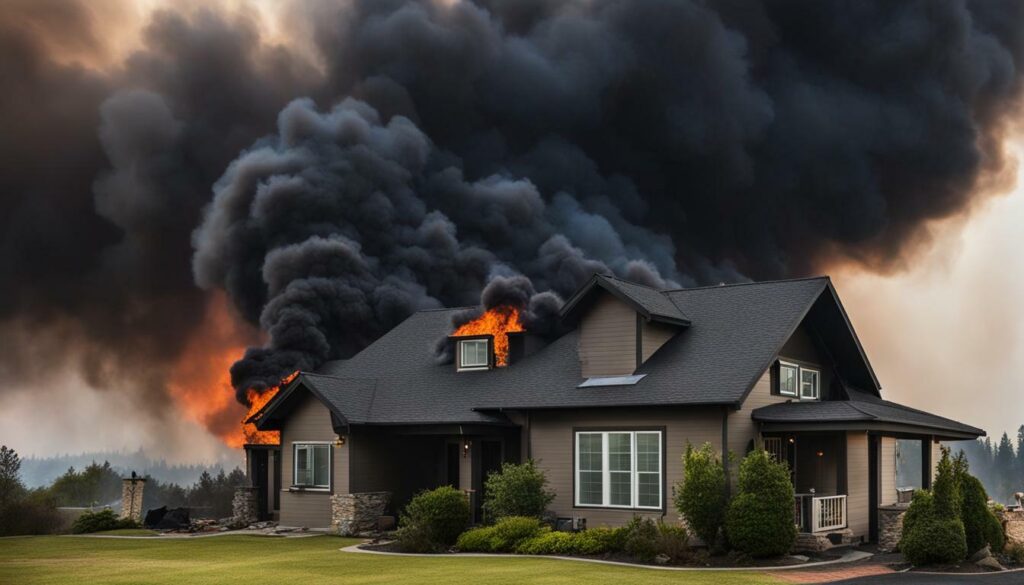
When it comes to fire-rated roofing solutions, asphalt shingles are highly recommended. They are designed to resist fire embers, fire radiation, and ignition, making them a reliable choice for fire-prone areas. The durability of asphalt shingles allows them to withstand high temperatures and protect your home from potential fire damage. This makes them an ideal option for homeowners looking for a cost-effective and long-lasting fire-resistant roofing material.
Advantages of Asphalt Shingles:
- Cost-effective: Asphalt shingles are relatively affordable compared to other fire-resistant roofing materials, making them a popular choice for homeowners on a budget.
- Wide availability: Asphalt shingles are readily available in various styles, colors, and designs, allowing homeowners to choose the option that best suits their aesthetic preferences.
- Easy installation: The installation process for asphalt shingles is straightforward, and many roofing contractors are familiar with this material, making it a convenient choice for homeowners.
- Low maintenance: Asphalt shingles require minimal maintenance, with occasional inspections and cleanings to ensure their longevity and effectiveness as fire-resistant roofing.
When selecting fire-resistant roofing materials for your home, it’s essential to consider the specific requirements of your area and the guidelines provided by the United States Forest Service. However, asphalt shingles remain a top choice for their durability, cost-effectiveness, and wide availability. They offer reliable fire protection while adding aesthetic value to your home.
| Fire-Resistant Rating | Roofing Material |
|---|---|
| Class A | Asphalt Shingles |
| Class A | Metal Roofing |
| Class A | Concrete and Clay Tiles |
| Class A | Synthetic Roofing Shingles (CeDUR) |
| Class A | Slate Tiles |
Concrete and Clay Tiles: Classic and Fire-Resistant Roofing Options
If you’re looking for a classic and fire-resistant roofing option, concrete and clay tiles are excellent choices. These materials provide a combination of timeless aesthetics and superior fire resistance, making them ideal for homes in fire-prone areas. Concrete and clay tiles are known for their non-combustible nature, which means they do not easily catch fire or contribute to the spread of flames. This makes them a safe and reliable option to protect your home from the devastating effects of wildfires.
Concrete and clay tiles are able to withstand high temperatures, making them highly effective in minimizing potential fire damage. These tiles have been used for centuries and have proven their durability and resistance to fire. Because they are made from natural materials, they are also environmentally friendly.
When it comes to aesthetics, concrete and clay tiles offer a wide range of styles and colors to choose from. Whether you prefer a traditional, rustic look or a more contemporary design, there is a concrete or clay tile option to suit your home’s architectural style. Their versatility allows you to enhance the curb appeal of your home while ensuring its safety and protection.
| Advantages of Concrete and Clay Tiles: |
|---|
| 1. Non-combustible roofing materials |
| 2. High resistance to fire and heat |
| 3. Durable and long-lasting |
| 4. Wide range of styles and colors |
| 5. Environmentally friendly |
When choosing fire-resistant roofing materials for your home, it is important to consider their fire resistance rating. Concrete and clay tiles are typically classified as Class A fire-resistant roofing materials, indicating the highest level of fire resistance. Although no roofing material is completely fireproof, opting for Class A-rated materials can significantly reduce the risk of fire damage to your home.
In conclusion, concrete and clay tiles are classic and fire-resistant roofing options that provide both aesthetic appeal and protection against wildfires. Their non-combustible nature, durability, and wide range of styles make them an excellent choice for homeowners in fire-prone areas. By investing in fire-resistant roofing materials like concrete and clay tiles, you can have peace of mind knowing that your home is well-equipped to withstand potential fires.
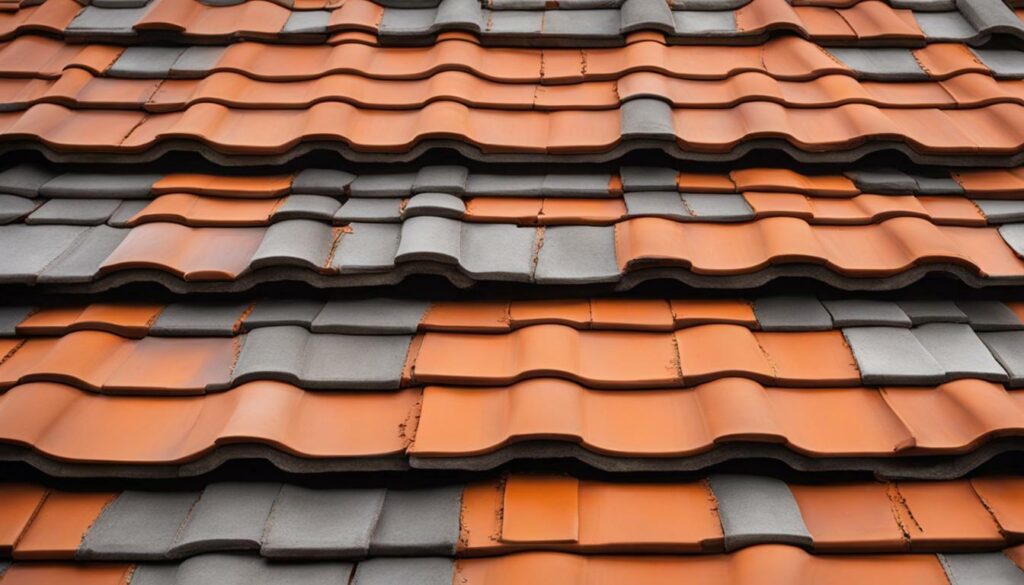
Slate tiles offer a natural and fire-resistant roofing solution, making them a popular choice in fire-prone areas. With their unique composition and durability, slate tiles provide homeowners with peace of mind knowing that their roof can withstand the heat and potential hazards of a wildfire.
One of the key benefits of slate tiles is their natural resistance to fire. Unlike other roofing materials that may contain flammable elements, slate is formed from metamorphic rock, making it inherently flame-resistant. Its dense and non-combustible nature acts as a barrier against fire, preventing it from spreading to the rest of the home.
Furthermore, slate tiles are known for their longevity and durability. They have a lifespan of up to 100 years, ensuring that your investment in fire-resistant roofing materials will last for generations. This durability also means that slate tiles require minimal maintenance, saving you time and money in the long run.
| Advantages of Slate Tiles: | Disadvantages of Slate Tiles: |
|---|---|
|
|
When considering the installation of slate tiles, it is important to consult with a professional roofing contractor who specializes in this material. Due to its weight, proper structural support may be necessary to ensure the stability of your home. A professional will also have the expertise to handle the intricacies of slate tile installation, ensuring a secure and long-lasting roof.
With its natural beauty, exceptional fire-resistant properties, and long lifespan, slate tiles are an excellent choice for homeowners seeking a fire-resistant roofing solution. Invest in the safety and protection of your home by considering slate tiles as your roofing material of choice in fire-prone areas.
Image:
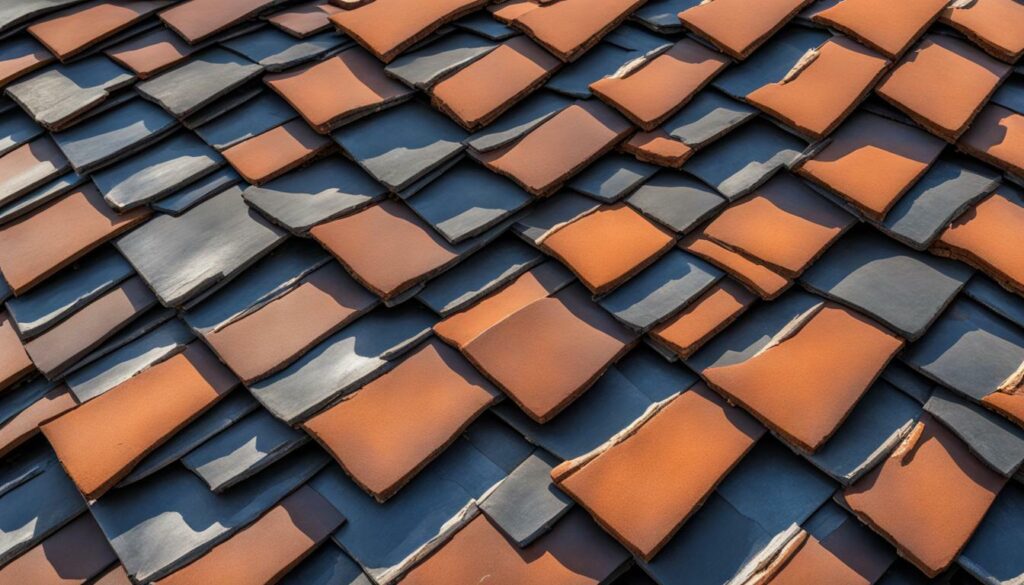
Metal roofing is a highly versatile and fire-resistant option, providing both aesthetic appeal and exceptional durability. Its sleek and modern design adds a touch of sophistication to any home, while its fire-resistant properties offer peace of mind in areas prone to wildfires.
One of the key advantages of metal roofing is its ability to withstand extreme temperatures and resist fire. Made from materials such as steel, aluminum, or copper, metal roofs have a high melting point and are non-combustible, making them an excellent choice for fire-resistant roofing. In fact, metal roofing materials often have the highest fire-resistance ratings, such as Class A, which is the most effective in resisting fire and preventing its spread.
Aside from its fire-resistant qualities, metal roofing is also known for its durability. With proper installation and maintenance, a well-made metal roof can last for decades, providing long-term protection for your home. It is resistant to cracking, warping, and shrinking, and can withstand extreme weather conditions, including high winds, heavy rain, and snow.
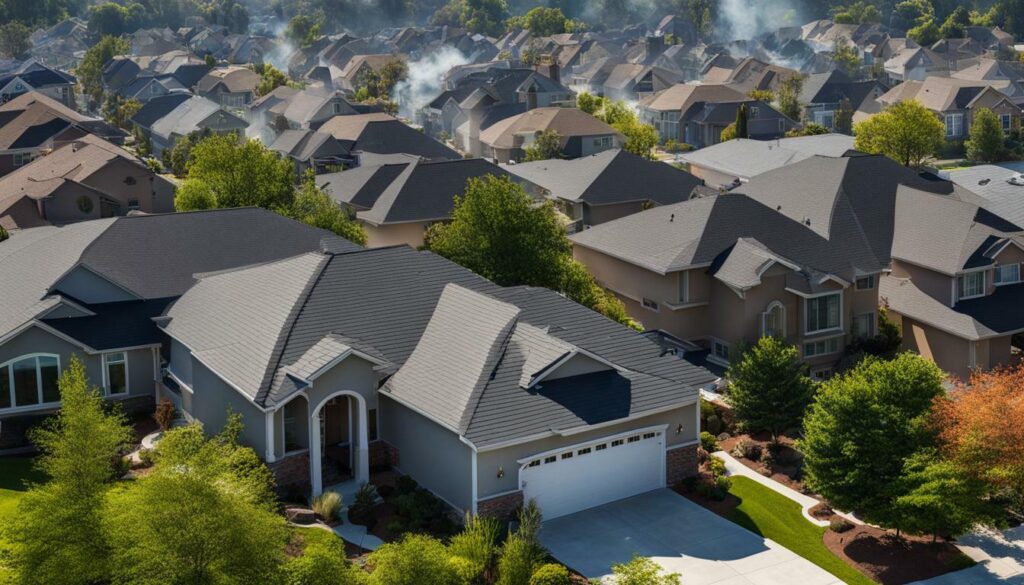
Additionally, metal roofing offers a wide range of design options to suit any architectural style. From traditional standing seam panels to metal shingles that mimic the look of slate or wood, there are numerous choices available to complement your home’s aesthetics. Metal roofs can also be customized in a variety of colors and finishes, allowing you to create a unique and visually appealing look.
In summary, metal roofing is a versatile and fire-resistant option that combines functionality, durability, and aesthetics. With its ability to withstand fire and provide long-lasting protection, it is an excellent choice for homeowners looking to safeguard their homes in fire-prone areas.
Synthetic Roofing Shingles: Safety, Aesthetics, and Fire Resistance Combined
For homeowners seeking a combination of safety, aesthetics, and fire resistance, synthetic roofing shingles like those from CeDUR are an excellent choice. These high-quality roofing materials offer numerous benefits that make them a top choice for fire-resistant roofing.
One key advantage of synthetic roofing shingles is their exceptional fire resistance. Made from a blend of innovative synthetic materials, these shingles are designed to be highly resistant to fire, protecting your home from potential fire damage. CeDUR’s synthetic shingles, in particular, boast a Stand Alone Class A Fire Rating, which is the highest level of fire resistance available. This rating ensures that the shingles can withstand exposure to flames and intense heat, offering an added layer of protection for your home.
With CeDUR synthetic roofing shingles, you can have peace of mind knowing that your home is equipped with durable and fire-resistant materials that can withstand the harshest fire conditions.
In addition to their fire resistance, synthetic roofing shingles also offer aesthetic appeal. They are carefully designed to replicate the natural look of wood shake or cedar shake, providing a beautiful and timeless appearance to your home. Whether you prefer a rustic, traditional, or modern style, synthetic roofing shingles can complement any architectural design.
Furthermore, synthetic roofing shingles are built to be durable and long-lasting. They are resistant to rot, mold, and discoloration, ensuring that your roof maintains its beauty and integrity for years to come. With minimal maintenance required, these shingles offer a cost-effective solution for homeowners who want both beauty and performance.
A Comparison of Fire-Resistant Roofing Materials
| Roofing Material | Fire Resistance | Aesthetics | Durability |
|---|---|---|---|
| Synthetic Roofing Shingles | Stand Alone Class A Fire Rating | Natural wood shake look | Rot and mold resistant |
| Concrete and Clay Tiles | Fireproof, non-combustible | Classic and timeless | Long-lasting |
| Slate Tiles | Naturally fire-resistant | Elegant and sophisticated | Highly durable |
| Metal Roofing | Class A rated fire resistance | Versatile styles and colors | Strong and long-lasting |
| Asphalt Shingles | Fire-rated options available | Wide range of styles | Durable and cost-effective |
When it comes to choosing the best fire-resistant roofing materials, synthetic roofing shingles stand out as a top option. With their combination of safety, aesthetics, and fire resistance, they provide an ideal solution for homeowners in fire-prone areas. Consult with a professional roofing contractor to determine the best roofing material for your specific needs and preferences, and enjoy the peace of mind that comes with knowing your home is protected.
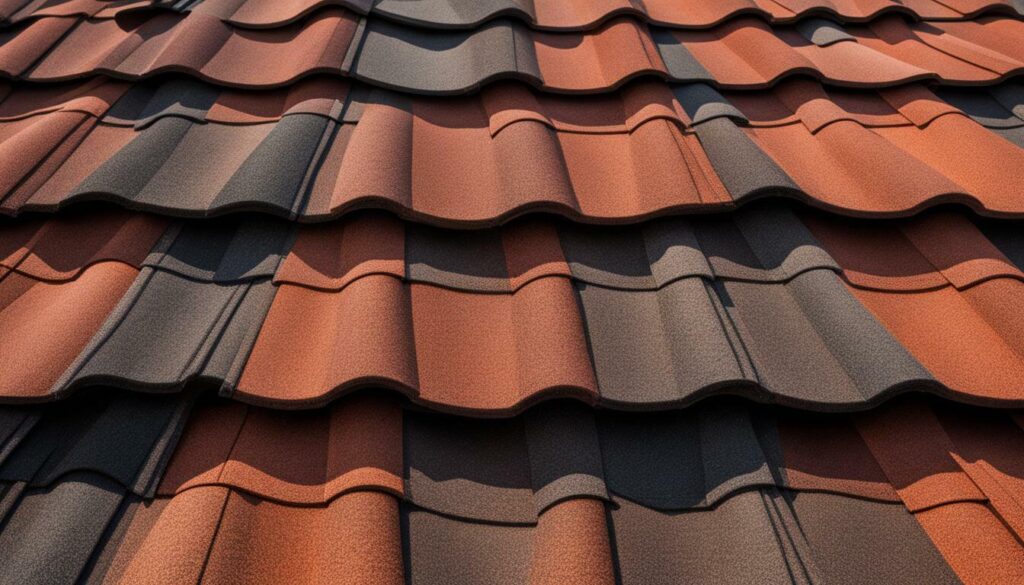
Disclaimer: This article is for informational purposes only. It is not intended to provide professional advice or recommendations. Please consult with a qualified roofing professional for an accurate assessment of your roofing needs.
The Importance of Class A Fire Ratings in Fire-Resistant Roofing Materials
When searching for fire-resistant roofing materials, it’s crucial to prioritize those with Class A fire ratings, as they offer the highest level of fire resistance. In areas prone to wildfires, such as the Wildland-Urban Interface (WUI), where homes are at higher risk, using Class A-rated materials can significantly reduce the potential for fire damage.
The United States Forest Service has established guidelines for creating wildfire-resistant homes in the WUI Code. This code emphasizes the use of fireproof roofing materials that can withstand fire embers, radiation, and ignition. By choosing Class A-rated fire-resistant roofing materials, homeowners can enhance the safety and protection of their properties.
There are several roofing options available that meet the Class A fire rating criteria. These include asphalt shingles, concrete and clay tiles, slate tiles, metal roofing, and synthetic roofing shingles. Each of these materials offers varying degrees of fire resistance, but all are designed to withstand the spread of wildfires to protect homes.
| Roofing Material | Fire Resistance Level |
|---|---|
| Asphalt Shingles | Class A |
| Concrete and Clay Tiles | Class A |
| Slate Tiles | Class A |
| Metal Roofing | Class A |
| Synthetic Roofing Shingles | Class A |
While no roofing material can be completely fireproof, utilizing those with high fire-resistance ratings, such as Class A materials, significantly reduces the risk of fire damage. It’s important to consult with roofing professionals who can guide homeowners in selecting the best fire-resistant roofing materials that meet their specific needs and budget.
By prioritizing fire-rated roofing solutions, homeowners can take proactive steps to safeguard their properties against the devastating effects of wildfires. Investing in Class A-rated fire-resistant roofing materials not only enhances the safety of homes but also provides peace of mind for homeowners in fire-prone areas.
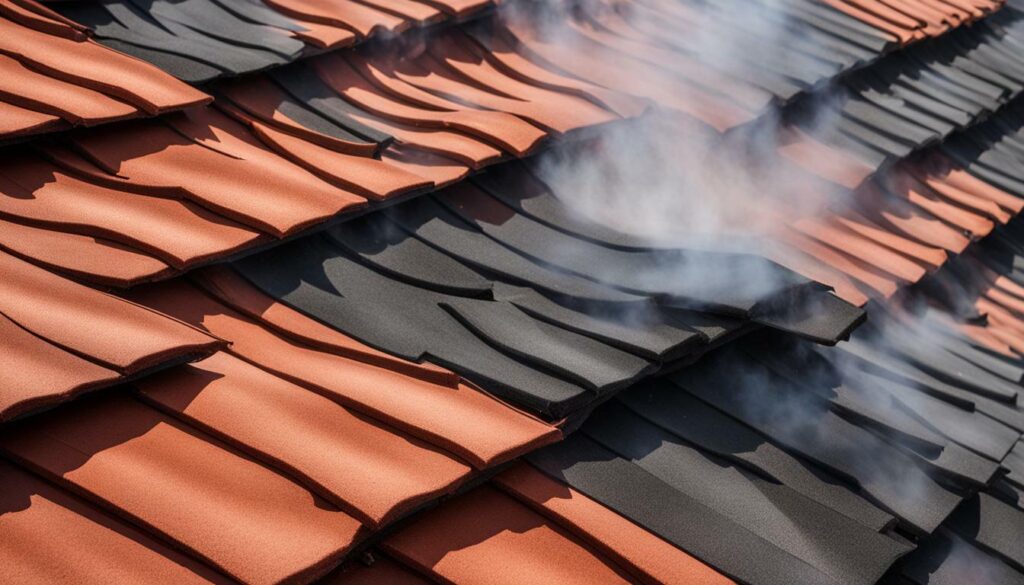
Choosing the right fire-resistant roofing materials involves considering various factors to ensure they meet your specific needs and requirements. The primary consideration should be the material’s ability to withstand and resist fire. Look for roofing materials that have high fire-resistance ratings, such as Class A materials. While no roofing material is completely fireproof, Class A-rated materials offer the highest level of fire resistance, significantly reducing the risk of fire damage to your home.
Another important factor to consider is durability. Fire-resistant roofing materials should be able to withstand extreme temperatures, high winds, and other weather conditions without deteriorating or requiring frequent repairs. Look for materials that are known for their durability, longevity, and ability to withstand the elements.
Cost is also a significant factor to consider. Fire-resistant roofing materials may come with a higher price tag compared to traditional roofing options. However, it is essential to weigh the upfront cost against the potential long-term savings. Fire-resistant materials can help protect your home from fire damage, potentially reducing repair and replacement costs in the event of a wildfire.
| Factors to Consider | Fire-Resistant Roofing Materials |
|---|---|
| Fire-Resistance Rating | Class A |
| Durability | Metal Roofing, Slate Tiles |
| Cost | Concrete and Clay Tiles |
Lastly, consider the suitability of the roofing material for your specific climate and region. Different materials may perform better in certain environments, so it’s important to choose a material that can withstand the specific weather conditions of your area. Consult with roofing professionals or contractors specializing in fire-resistant roofing to determine the best material for your home.
Choosing fire-resistant roofing materials is a crucial investment in protecting your home and ensuring the safety of your family. By considering factors such as fire-resistance ratings, durability, cost, and suitability for your climate, you can make an informed decision that provides long-lasting protection and peace of mind.
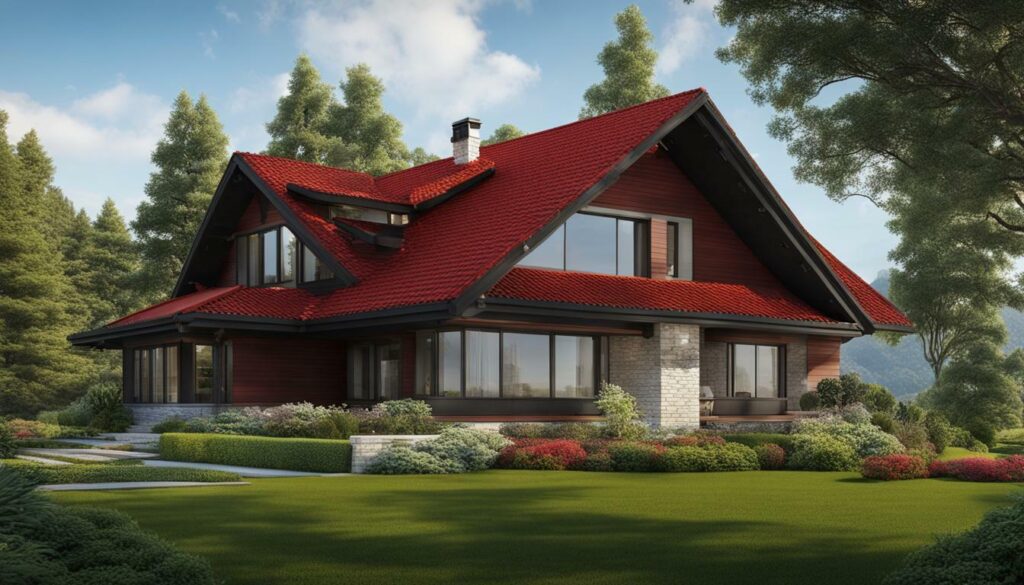
Proper installation and regular maintenance are essential for maximizing the effectiveness of fire-resistant roofing materials. When it comes to installation, it is crucial to enlist the help of professionals who are experienced in working with fire-resistant roofing materials. They have the expertise to ensure that the materials are installed correctly, minimizing any potential vulnerabilities that could compromise their fire-resistant properties.
Maintaining fire-resistant roofing materials involves regular inspections and upkeep. It is important to inspect the roof regularly for any signs of damage, such as cracked tiles or loose shingles. Prompt repairs should be made to address these issues and maintain the integrity of the fire-resistant barrier.
Cleaning the roof is also a crucial part of maintenance. Regular removal of debris, such as leaves, branches, and pine needles, can help prevent the accumulation of flammable materials. Additionally, trimming tree branches that overhang the roof can reduce the risk of fire embers igniting the roofing material.
Remember, not all fire-resistant roofing materials require the same level of maintenance. Some materials, like metal roofing, require minimal upkeep, while others, such as clay tiles, may need regular sealing to ensure their fire resistance. Consult the manufacturer’s guidelines or seek advice from roofing professionals to determine the specific maintenance requirements for your chosen fire-resistant roofing material.

- Regularly inspect the roof for any signs of damage.
- Address any repairs promptly to maintain the integrity of the fire-resistant barrier.
- Clean the roof regularly to remove debris that can act as fuel for fires.
- Trim tree branches that overhang the roof to reduce the risk of fire embers igniting the roofing material.
- Follow the manufacturer’s guidelines or seek professional advice for specific maintenance requirements.
By following proper installation and maintenance practices, you can ensure that your fire-resistant roofing materials remain effective in protecting your home from the devastating impact of wildfires. Remember, investing in fire-resistant roofing materials is an important step in safeguarding your property and the safety of your loved ones.
Financial and Insurance Considerations for Fire-Resistant Roofing
Installing fire-resistant roofing materials can have financial benefits, including potential cost savings, insurance discounts, and increased property value. When it comes to protecting your home from the devastating effects of wildfires, investing in fire-resistant roofing materials can be a wise decision. These materials are designed to withstand high temperatures and impede the spread of flames, providing an added layer of protection for your home.
One of the financial benefits of fire-resistant roofing materials is the potential cost savings. While these materials may have a higher upfront cost compared to traditional roofing options, they can save you money in the long run. Fire-resistant roofs are less likely to sustain severe damage during a fire, reducing the need for costly repairs or replacements. Additionally, with a fire-resistant roof in place, you may be eligible for insurance discounts. Insurance companies often offer lower premiums to homeowners who take proactive measures to protect their properties from fire hazards.
In addition to cost savings, installing fire-resistant roofing materials can also increase the value of your property. Potential buyers value homes that are equipped with fire-resistant features, especially in fire-prone areas. A fire-resistant roof provides peace of mind and reassurance to buyers, knowing that their investment is better protected against potential wildfires. This can translate into a higher resale value and a quicker sale when compared to homes without fire-resistant roofing.
To fully understand the financial and insurance benefits of fire-resistant roofing materials, it is recommended to consult with your insurance provider. They can provide specific details on the discounts and savings available to you based on the roofing materials you choose. Additionally, it is important to consider local building codes and guidelines when selecting fire-resistant roofing materials to ensure compliance and maximize the financial and insurance benefits.
By investing in fire-resistant roofing materials, you not only protect your home and loved ones from the dangers of wildfires, but you also set yourself up for potential cost savings, insurance discounts, and increased property value. So, prioritize safety, consider the financial implications, and make an informed decision when choosing fire-resistant roofing materials for your home.
Table: Financial and Insurance Considerations for Fire-Resistant Roofing
| Consideration | Explanation |
|---|---|
| Cost Savings | Fire-resistant roofing materials may save you money in the long run by reducing the need for costly repairs or replacements due to fire damage. |
| Insurance Discounts | Insurance companies often offer lower premiums to homeowners with fire-resistant roofs, as they are considered less of a fire risk. |
| Increased Property Value | Homes equipped with fire-resistant roofing materials have higher resale value and may attract more potential buyers in fire-prone areas. |
Conclusion
Investing in fire-resistant roofing materials is crucial for safeguarding your home and minimizing the risk of fire damage. In areas prone to wildfires, it is essential to prioritize safety by choosing materials that can impede the spread of fires and protect your home from severe damage.
The United States Forest Service has set guidelines in the Wildland-Urban Interface (WUI) Code, which outlines the requirements for creating wildfire-resistant homes. These guidelines emphasize the use of fireproof roofing materials that are resistant to fire embers, radiation, and ignition.
There are several options available when it comes to fire-resistant roofing materials. Asphalt shingles, concrete and clay tiles, slate tiles, metal roofing, and synthetic roofing shingles are all examples of materials that offer high fire-resistance ratings. While no roofing material is completely fireproof, choosing materials with Class A ratings can significantly reduce the risk of fire damage.
Synthetic roofing shingles, such as those offered by CeDUR, provide a combination of aesthetics, safety, and durability. They have earned a Stand Alone Class A Fire Rating and WUI approval, making them an excellent choice for homeowners looking for both style and fire resistance.
Remember, when selecting fire-resistant roofing materials, consider factors such as durability, cost, maintenance requirements, and suitability for your specific climate and region. Prioritize professional installation and regular maintenance to ensure the continued effectiveness of these materials.
By investing in fire-resistant roofing materials, you are not only protecting your home but also contributing to the safety and well-being of your community. Make an informed choice and prioritize safety by selecting fire-safe roofing options for your home.
FAQ
Q: Why are fire-resistant roofing materials important?
A: Fire-resistant roofing materials are crucial in areas prone to wildfires as they can impede the spread of fires and protect homes from severe damage.
Q: What are the guidelines for wildfire-resistant homes?
A: The United States Forest Service has set guidelines in the Wildland-Urban Interface (WUI) Code, which specifies the use of fireproof roofing materials that are resistant to fire embers, fire radiation, and ignition.
Q: What are some fire-resistant roofing material options?
A: Fire-resistant roofing material options include asphalt shingles, concrete tiles, clay tiles, slate tiles, metal roofing, and synthetic roofing shingles.
Q: What are the benefits of synthetic roofing shingles?
A: Synthetic roofing shingles, like those offered by CeDUR, provide a combination of aesthetics, safety, and durability, with a Stand Alone Class A Fire Rating and WUI approval.
Q: Which roofing materials have high fire-resistance ratings?
A: Metal roofing, asphalt shingles, concrete and clay tiles, and synthetic roofing shingles are all examples of Class A-rated fire-resistant roofing materials.
Q: Are there completely fireproof roofing materials?
A: No roofing material is completely fireproof, but choosing materials with high fire-resistance ratings, such as Class A materials, can significantly reduce the risk of fire damage.
